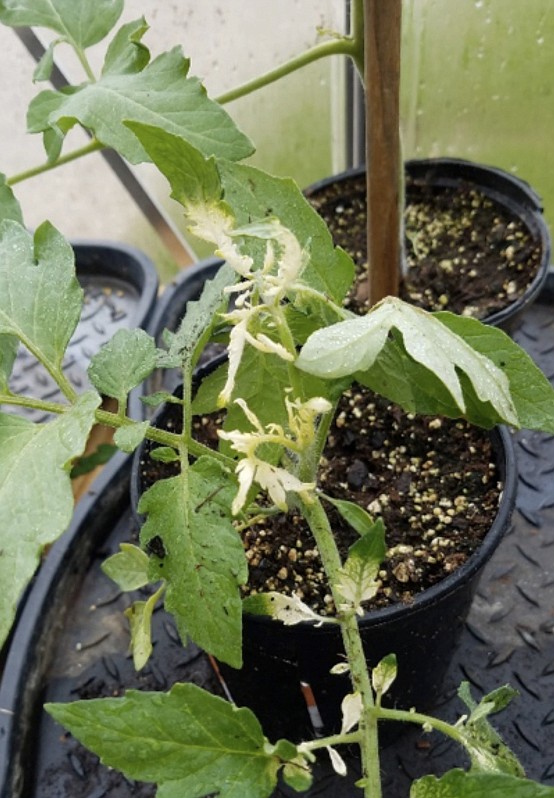Q: Is this damage from the herbicide glyphosate (aka Roundup)? Will it come out of it? I just don't see how I could have done this. I grow my own plants in my home greenhouse. It didn't happen to all of the plants and this variety seems the worst. (see photo)
A: The symptoms are very consistent with mild glyphosate damage on tomatoes. If it was moderate or severe damage, additional foliage would be showing damage, such as yellowing, browning or twisting. There is a good chance the plants will recover, if these more severe symptoms don't develop within a week. There is some difference between varieties of tomatoes to herbicides. There is some information on this specific to 2, 4-D, which causes notable twisting of growth (we've had one tomato sample from it this spring). Generally, greenhouse and heirloom varieties are more susceptible to accidental herbicide contamination, than are hybrid field tomatoes. Lastly, remember tomatoes are about the most sensitive common garden plant to herbicides.
How one "does it to one's self" can be very challenging to figure out. Since these were protected in a greenhouse, I'll assume it wasn't from spot spraying nearby. Here's some odd things a person might not consider to cause mild damage symptoms:
Spraying of a herbicide and getting some on ones clothes (e.g. pant legs) and then later brushing up against that plant.
Mixing of an herbicide and getting a little bit of concentrate or solution on one's hand. Then not washing ones hand well and later working with the plant.
Cross contamination with a measuring spoon. Dedicate measuring spoons for fungicides and insecticides as separate for those used for herbicides (as one should with pesticide sprayers too). Have separate measuring spoons or similar for fertilizers.
Q: Do you have information on dealing with storm-damaged trees?
A: Yes, we have a publication created in 2007, after the big ice storm that hit Springfield. It was updated two years ago. "First Aid for Storm-Damaged Trees" walks through the steps to take. It starts with "Be Patient," "Be Safe" and then "Don't be a Victim of a Scam." Then it goes into "Access the Damage" and provides eight evaluation criteria. Then is "Make a Decision" which is "Keep It," "Wait and See," or "Replace It." The basic first aid tips are to resist the urge to over-prune, remove any broken branches still attached, and repair torn bark. You can get it at extension2.missouri.edu/g6867 or pick up a copy at our extension center. While our extension center is quite close to the tornado path, we were fortunate to not suffer any damage.
Q: I noticed some trees leafing out very late. What's going on?
A: Mimosa trees are marginally adapted to Missouri winters, so when we have a severe one, they struggle with their spring growth. They have come out now, and this is a good time to prune out any dead branches. Other trees that are more southern types, may have struggled similarly.
Sycamore trees are suffering from a foliar disease that kills the new spring growth. Wet and cool weather aggravate this disease (Anthracnose). Some trees are severely affected and look extremely sparse, while others just don't seem very lush (which most trees are with all the rain). While we have moved into warmer temperatures, with the continued rain and humidity, the disease may remain active for some time. Eventually the hot, dry temperatures will bring an end to this foliar fungal disease for this summer.
Q: I have a turf-type tall fescue lawn. Some other cool season grass has gotten into it. I can recognize those clumps. What's the best way to fix this situation?
A: I hope we aren't talking about a very large area, as the remedy requires some attention to detail. In late July or early August, you want to kill these little clumps. The most effective way is glyphosate (aka Roundup, but with "only" glyphosate as an active ingredient). Very carefully go around and spot treat them. In early September, you will want to overseed some of your desired turf-type tall fescue. Scratching that seed into the "dead spots" by aggressively raking it in will help. If you can rake out these dead clumps even better. Keep any seeded grass watered for two weeks to improve its germination and emergence.

